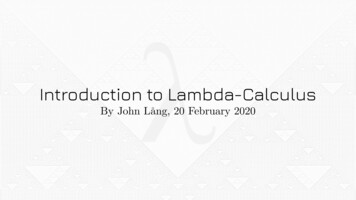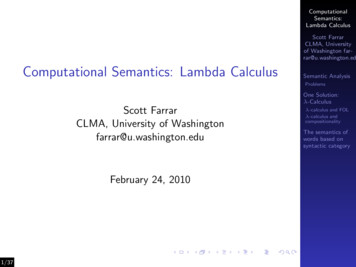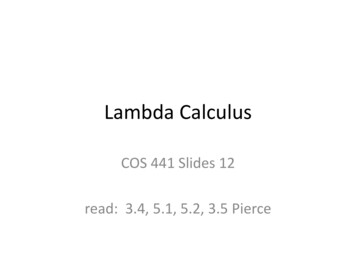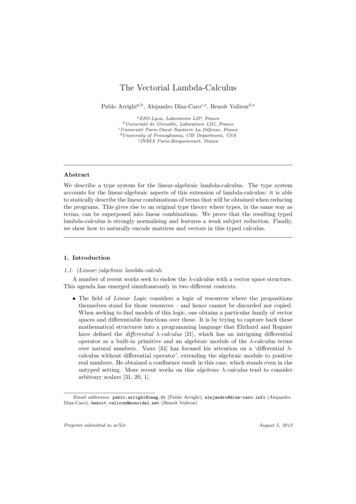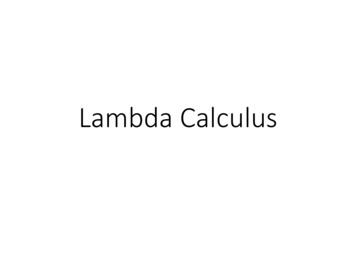
Transcription
Lambda Calculus
What is l-calculus Programming language Invented in 1930s, by Alonzo Church and Stephen ColeKleene Model for computation Alan Turing, 1937: Turing machines equal l-calculus inexpressiveness
Why learn l-calculus Foundations of functional programming Lisp, ML, Haskell, Often used as a core language to study languagetheories Type systemint x 0;Scope and bindingfor (int i 0; i 10; i ) { x ; }Higher-order functionsx “abcd”; // bug (mistype)Denotational semanticsi ; // bug (out of scope)Program equivalence How to formally define andrule out these bugs?
Overview: l-calculus as a language Syntax How to write a program? Keyword “l” for defining functions Semantics How to describe the executions of a program? Calculation rules called reduction Others Type system (next class) Model theory (not covered)
Syntax l terms or l expressions:(Terms) M, N :: x lx. M M N Lambda abstraction (lx.M): “anonymous” functionsint f (int x) { return x; } èlx. x Lambda application (M N):int f (int x) { return x; }f(3);è (lx. x) 3 3
Syntax l terms or l expressions:(Terms) M, N :: x lx. M M N pure l-calculus Add extra operations and data types lx. (x 1) lz. (x 2*y z) (lx. (x 1)) 3 3 1 (lz. (x 2*y z)) 5 x 2*y 5
Conventions Body of l extends as far to the right as possiblelx. M N means lx. (M N), not (lx. M) N lx. f x lx. ( f x ) lx. lf. f x lx. ( lf. f x ) Function applications are left-associativeM N P means (M N) P, not M (N P) (lx. ly. x - y) 5 3 ( (lx. ly. x - y) 5 ) 3 (lf. lx. f x) (lx. x 1) 2 ( (lf. lx. f x) (lx. x 1) ) 2
Higher-order functions Functions can be returned as return valueslx. ly. x - y Functions can be passed as arguments(lf. lx. f x) (lx. x 1) 2Think about function pointers in C/C .
Higher-order functions Given function f, return function f flf. lx. f (f x) How does this work?(lf. lx. f (f x)) (ly. y 1) 5 (lx. (ly. y 1) ((ly. y 1) x)) 5 (lx. (ly. y 1) (x 1)) 5 (lx. (x 1) 1) 5 5 1 1 7
Curried functions Note difference betweenlx. ly. x - yandint f (int x, int y) { return x - y;} l abstraction is a function of 1 parameter But computationally they are the same (can betransformed into each other) Curry: transform l(x, y). x-y to lx. ly. x - y Uncurry: the reverse of Curry
Free and bound variables lx. x y x: bound variable y: free variableint y; Could be aglobal variable int add(int x) {return x y;}
Free and bound variables lx. x y Bound variable can be renamed (“placeholder”) lx. (x y) is same function as lz. (z y)a-equivalence (x y) is the scope of the binding lxint add(int x) {int add(int z) {return x y;return z y;}x 0; // out of scope!}
Free and bound variables lx. x y Bound variable can be renamed (“placeholder”) lx. (x y) is same function as lz. (z y) (x y) is the scope of the binding lxa-equivalence Name of free variable does matter lx. (x y) is not the same as lx. (x z)int y 10;int y 10;int z 20;int z 20;int add(int x) { return x y; }int add(int x) { return x z; }
Free and bound variables lx. x y Bound variable can be renamed (“placeholder”) lx. (x y) is same function as lz. (z y) (x y) is the scope of the binding lxa-equivalence Name of free variable does matter lx. (x y) is not the same as lx. (x z) Occurrences (lx. x y) (x 1) : x has botha free and a bound occurrenceint x 10;int add(int x) { return x y;}add(x 1);
Formal definitions about free andbound variables Recall M, N :: x lx. M M N fv(M): the set of free variables in Mfv(x)º {x}fv(lx.M) º fv(M) \ {x}fv(M N) º fv(M) È fv(N) Examplefv((lx. x) x) {x}fv((lx. x y) x) {x, y}Defined byinduction on terms
Formal definitions about free andbound variables Recall M, N :: x lx. M M N fv(M): the set of free variables in M “x is a free variable in M”: x Î fv(M) “x is a bound variable in M”: ? a-equivalence:lx. M ly. M[y/x], where y freshSubstitution (defined later)
Main points till now Syntax: notation for defining functions(Terms) M, N :: x lx. M M N Next: semantics (reduction rules)
Overview of reduction Basic rule is b-reduction(lx. M) N M[N/x](Substitution) Repeatedly apply reduction rule to any sub-termExample(lf. lx. f (f x)) (ly. y 1) 5 (lx. (ly. y 1) ((ly. y 1) x)) 5 (lx. (ly. y 1) (x 1)) 5 (lx. (x 1) 1) 5 5 1 1 7
Substitution M[N/x]: replace x by N in M Defined by induction on termsx[N/x] º Ny[N/x] º y(M P)[N/x] º (M[N/x]) (P[N/x])(lx.M)[N/x] º lx.M (Only replace free variables!)(ly.M)[N/x] º ?Because names of boundvariables do not matter
Substitution – avoid name capture Example : (lx. x - y)[x/y]Substitute “blindly”:lx. x - xProblem: unintended name capture!!Solution: rename bound variables before substitution(lx. x - y)[x/y] (lz. z - y)[x/y] lz. z - x
Substitution – avoid name capture Example : (lx. f (f x))[(ly. y x)/f]Substitute “blindly”:lx. (ly. y x) ((ly. y x) x)Problem: x in (ly. y x) got bound – unintended namecapture!!Solution: rename bound variables before substitution(lx. f (f x))[(ly. y x)/f] (lz. f (f z))[(ly. y x)/f] lz. (ly. y x) ((ly. y x) z)
Substitution M[N/x]: replace x by N in Mx[N/x] º Ny[N/x] º y(M P)[N/x] º (M[N/x]) (P[N/x])(lx.M)[N/x] º lx.M(ly.M)[N/x] º ly.(M[N/x]), if y Ï fv(N)z is unused(ly.M)[N/x] º lz.(M[z/y][N/x]), if y Î fv(N) and z freshEasy rule: always rename variables to be distinct
Examples of substitution(lx. (ly. y z) (lw. w) z x)[y/z](lx. (ly. y y) z x)[(f x)/z]
Reduction rulesλ𝑥. 𝑀 𝑁 𝑀[𝑁/𝑥](b)𝑀 𝑀′𝑀 𝑁 𝑀! 𝑁𝑁 𝑁′𝑀 𝑁 𝑀 𝑁′𝑀 𝑀′λ𝑥. 𝑀 λ𝑥. 𝑀′Repeatedly apply(b) to any sub-term
Examples(lf. f x) (ly. y) // apply (b) (f x)[(ly. y)/f] (ly. y) x y[x/y] x// apply (b)
Examples(ly. lx. x - y) x (lx. x - y)[x/y]// apply (b) lz. ((x - y)[z/x][x/y]) lz. ((z - y)[x/y]) lz. z - x
Exampleslx. (ly. y 1) x // 4th rule(ly. y 1) x // (b) rule (y 1)[x/y] lx. x 1 x 1
Examples(lf. lz. f (f z)) (ly. y x)// apply (b) lz. (ly. y x) ((ly. y x) z) // apply (b) and the 3rd &4th rules lz. (ly. y x) (z x) lz. z x x// apply (b) and the 4th rule
Normal formreducible expression b-redex: a term of the form (lx.M) N b-normal form: a term containing no b-redex Stopping point: cannot further apply b-reduction rules(lf. lx. f (f x)) (ly. y 1) 2 ( lx. (ly. y 1) ((ly. y 1) x) ) 2 ( lx. (ly. y 1) (x 1) ) 2 ( lx. x 1 1 ) 2 2 1 1(b-normal form)Can further reduce to 4 if having reduction rules for
Normal form – examples lx. ly. x Yes (lx. ly. x) (lz. z) No lx. (ly. x) (lz. z) No
Confluence (Church-Rosser Property)Terms can be evaluated in any order.Final result (if there is one) is uniquely determined.(lf. lx. f (f x)) (ly. y 1) 2 ( lx. (ly. y 1) ((ly. y 1) x) ) 2 ( lx. (ly. y 1) (x 1) ) 2 ( lx. x 1 1 ) 2 2 1 1(lf. lx. f (f x)) (ly. y 1) 2 ( lx. (ly. y 1) ((ly. y 1) x) ) 2 ( lx. (ly. y 1) (x 1) ) 2 (ly. y 1) (2 1) 2 1 1
Formalizing Confluence Theorem M * M’ : zero-or-more steps of M 0 M’ iff M M’M k 1 M’ iff M’’. M M’’ Ù M’’ k M’M * M’ iff k. M k M’ Confluence Theorem:If M * M1 and M * M2,then there exists M’ such thatM1 * M’ and M2 * M’.inductivedefinitionMM1M2M’
Corollary of Confluence Theorem With a-equivalence, every term has at most onenormal form. Q: If a term has many b-redexes, which b-redexshould be picked? Good news: no matter which is picked, there is atmost one normal form. Bad news: some reduction strategies may fail tofind a normal form.
Non-terminating reduction(lx. x x) (lx. x x) (lx. x x) (lx. x x) (lx. x x y) (lx. x x y) (lx. x x y) (lx. x x y) y (lx. f (x x)) (lx. f (x x)) f ((lx. f (x x)) (lx. f (x x))) Some terms have no normal forms
Term may have both terminating andnon-terminating reduction sequences(lu. lv. v) ((lx. x x)(lx. x x)) lv. v(lu. lv. v) ((lx. x x)(lx. x x)) (lu. lv. v) ((lx. x x)(lx. x x)) Some reduction strategies may fail to find a normal form
Reduction strategies Normal-order reduction: choose the left-most,outer-most redex first(lu. lv. v) ((lx. x x)(lx. x x)) lv. vTheorem:Normal-order reduction willfind normal form if exists Applicative-order reduction: choose the left-most,inner-most redex first(lu. lv. v) ((lx. x x)(lx. x x)) (lu. lv. v) ((lx. x x)(lx. x x))
Reduction strategies – examplesNormal-order(lx. x x) ((ly. y) (lz. z)) ((ly. y) (lz. z)) ((ly. y) (lz. z)) (lz. z) ((ly. y) (lz. z)) (ly. y) (lz. z) lz. zApplicative-order(lx. x x) ((ly. y) (lz. z)) (lx. x x) (lz. z) (lz. z) (lz. z) lz. z
Reduction strategies – examplesNormal-orderApplicative-order(le. lf. e) ((la. lb. a) x y) ((lc. ld. c) u v)
Reduction strategies – examplesApplicative-order may not be as efficient as normal-orderwhen the argument is not used.Normal-orderApplicative-order(lx. p) ((ly. y) (lz. z)) p(lx. p) ((ly. y) (lz. z)) (lx. p) (lz. z) p
Reduction strategies Similar to (but subtly different from) evaluationstrategies in language theoriesarguments are not Call-by-name (like normal-order) ALGOL 60evaluated, butdirectly substitutedinto function body Call-by-need (“memorized version” of call-by-name) Haskell, R, called “lazy evaluation” Call-by-value (like applicative-order) C, called “eager evaluation”
Subtle difference between reductionstrategies and evaluation strategies Normal-order (or applicative-order) reduces underlambda Allow optimizations inside a function body Not always desired lx. ((ly. y y) (ly. y y)) lx. ((ly. y y) (ly. y y)) Evaluation strategies: Don’t reduce under lambda
Evaluation Only evaluate closed terms (i.e. no free variables) May not reduce all the way to a normal form Terminate as soon as a canonical form (i.e. a lambdaabstraction) is obtainedEvaluationterminateshere
Evaluation A closed normal form must be a canonical form Not every closed canonical form is a normal form Recall that normal-order reduction will find thenormal form if it exists If normal-order reduction terminates, the reductionsequence must contain a first canonical form Normal-order evaluation
Normal-order reduction & evaluation Normal-order reduction terminatesEvaluation terminates here Normal-order reduction does not terminateEvaluation terminates hereEvaluation diverges too
Normal-order evaluation rulesλ𝑥. 𝑀 λ𝑥. 𝑀(Term)𝑀 λ𝑥. 𝑀!𝑀! [𝑁/𝑥] 𝑃(b)𝑀𝑁 𝑃
Normal-order evaluation – example
Recall the reduction strategiesNormal-orderApplicative-order(lx. x x) ((ly. y) (lz. z))(lx. x x) ((ly. y) (lz. z)) ((ly. y) (lz. z)) ((ly. y) (lz. z)) (lx. x x) (lz. z) (lz. z) ((ly. y) (lz. z)) (lz. z) (lz. z) (ly. y) (lz. z) lz. z lz. zEager evaluation:Postpone the substitution untilthe argument is a canonical form.No need to reduce many copiesof the argument separately.
Eager evaluation rulesλ𝑥. 𝑀 " λ𝑥. 𝑀𝑀 " λ𝑥. 𝑀!(Term)𝑁 " 𝑁 !𝑀! [𝑁′/𝑥] " 𝑃(b)𝑀 𝑁 " 𝑃
Eager evaluation– example
Normal-order evaluation rules(small-step)(λ𝑥. 𝑀) 𝑁 𝑀[𝑁/𝑥]𝑀 𝑀!𝑀 𝑁 𝑀! 𝑁(b)
Eager evaluation rules (small-step)λ𝑥. 𝑀 (λy. 𝑁) 𝑀[(λy. 𝑁)/𝑥]𝑀 𝑀!𝑀 𝑁 𝑀! 𝑁𝑁 𝑁!λ𝑥. 𝑀 𝑁 (λ𝑥. 𝑀) 𝑁′(b)
Main points till now Syntax: notation for defining functions(Terms) M, N :: x lx. M M N Semantics (reduction rules)(lx. M) N M[N/x](b) Next: programming in l-calculus Encoding data and operators in “pure” l-calculus(without adding any additional syntax)
Programming in l-calculus Encoding Boolean values and operators True º lx. ly. x False º lx. ly. y
Programming in l-calculus Encoding Boolean values and operators True º lx. ly. x False º lx. ly. y not º
Programming in l-calculus Encoding Boolean values and operators True º lx. ly. x False º lx. ly. y not º lb. b False Truenot True True False True Falsenot False False False True True
Programming in l-calculus Encoding Boolean values and operators True º lx. ly. x False º lx. ly. y not º lb. b False True and º
Programming in l-calculus Encoding Boolean values and operators True º lx. ly. x False º lx. ly. y not º lb. b False True and º lb. lb’. b b’ Falseand True b * True b False band False b * False b False False
Programming in l-calculus Encoding Boolean values and operators True º lx. ly. x False º lx. ly. y not º lb. b False True and º lb. lb’. b b’ False or º
Programming in l-calculus Encoding Boolean values and operators True º lx. ly. x False º lx. ly. y not º lb. b False True and º lb. lb’. b b’ False or º lb. lb’. b True b’or True b * True True b Trueor False b * False True b b
Programming in l-calculus Encoding Boolean values and operators True º lx. ly. x False º lx. ly. y not º lb. b False True and º lb. lb’. b b’ False or º lb. lb’. b True b’ if b then M else N º
Programming in l-calculus Encoding Boolean values and operators True º lx. ly. x False º lx. ly. y not º lb. b False True and º lb. lb’. b b’ False or º lb. lb’. b True b’ if b then M else N º b M N
Programming in l-calculus Encoding Boolean values and operators True º lx. ly. x False º lx. ly. y not º lb. b False True and º lb. lb’. b b’ False or º lb. lb’. b True b’ if b then M else N º b M N not’ º lb. lx. ly. b y xnot’ True lx. ly. True y x lx. ly. y Falsenot’ False lx. ly. False y x lx. ly. x True
Programming in l-calculus Church numerals 0 º lf. lx. x 1 º lf. lx. f x 2 º lf. lx. f (f x) n º lf. lx. fn x
Programming in l-calculus Church numerals 0 º lf. lx. x 1 º lf. lx. f x 2 º lf. lx. f (f x) n º lf. lx. fn x succ º
Programming in l-calculus Church numerals 0 º lf. lx. x 1 º lf. lx. f x 2 º lf. lx. f (f x) n º lf. lx. fn x succ º ln. lf. lx. f (n f x)succ n lf. lx. f (n f x) lf. lx. f ((lf. lx. fn x) f x) lf. lx. f (fn x) lf. lx. fn 1 x n 1
Programming in l-calculus Church numerals 0 º lf. lx. x 1 º lf. lx. f x 2 º lf. lx. f (f x) n º lf. lx. fn x succ º ln. lf. lx. f (n f x) succ’ º ln. lf. lx. n f (f x)succ’ n * n 1
Programming in l-calculus Church numerals 0 º lf. lx. x 1 º lf. lx. f x 2 º lf. lx. f (f x) n º lf. lx. fn x succ º ln. lf. lx. f (n f x) iszero º
Programming in l-calculus Church numerals 0 º lf. lx. x 1 º lf. lx. f x 2 º lf. lx. f (f x) n º lf. lx. fn x succ º ln. lf. lx. f (n f x) iszero º ln. lx. ly. n (lz. y) xiszero 0 lx. ly. 0 (lz. y) x lx. ly. (lf. lx. x) (lz. y) x lx. ly. (lx. x) x lx. ly. x Trueiszero 1 lx. ly. 1 (lz. y) x lx. ly. (lf. lx. f x) (lz. y) x lx. ly. (lx. (lz. y) x) x lx. ly. ((lz. y) x) lx. ly. y Falseiszero (succ n) * False
Programming in l-calculus Church numerals 0 º lf. lx. x 1 º lf. lx. f x 2 º lf. lx. f (f x) n º lf. lx. fn x succ º ln. lf. lx. f (n f x) iszero º ln. lx. ly. n (lz. y) x add º ln. lm. lf. lx. n f (m f x) mult º ln. lm. lf. n (m f)
Programming in l-calculus Pairs (M, N) º lf. f M N p0 º lp. p (lx. ly. x) p1 º lp. p (lx. ly. y)p0(M, N) * Mp1(M, N) * N
Programming in l-calculus Pairs (M, N) º lf. f M N p0 º lp. p (lx. ly. x) p1 º lp. p (lx. ly. y) Tuples (M1, , Mn) º lf. f M1 Mn pi º lp. p (lx1. lxn. xi)
Programming in l-calculus Recursive functions fact(n) if (n 0) then 1 else n * fact(n-1) To find fact, we need to solve an equation!
Fixpoint in arithmetic x is a fixpoint of f if f(x) x Some functions has fixpoints, while others don’t f(x) x * x. Two fixpoints 0 and 1. f(x) x 1. No fixpoint. f(x) x. Infinitely many fixpoints.
fact is a fixpoint of a function x is a fixpoint of f if f(x) xfact(n) if (n 0) then 1 else n * fact(n-1)fact ln. if (n 0) then 1 else n * fact(n-1)fact (lf. ln. if (n 0) then 1 else n * f(n-1)) factLet F lf. ln. if (n 0) then 1 else n * f(n-1).Then fact F fact. So fact is a fixpoint of F.
In l-calculus, every term has afixpoint Fixpoint combinator is a higher-order function hsatisfyingfor all f, (h f) gives a fixpoint of fi.e. h f f (h f) Turing’s fixpoint combinator QLet A lx. ly. y (x x y) and Q A A Church’s fixpoint combinator YLet Y lf. (lx. f (x x)) (lx. f (x x))
Turing’s fixpoint combinator Q Let A lx. ly. y (x x y) and Q A A Let’s prove: for all f, Q f f (Q f)
Solving factLet F lf. ln. if (n 0) then 1 else n * f(n-1).fact is a fixpoint of F.fact Q FThe right-hand side is a closed lambda term thatrepresents the factorial function.
Comments on computabilityTuring’s Turing machine, Church’s l-calculus andGödel’s general recursive functions are equivalent toeach other in the sense that they define the sameclass of functions (a.k.a computable functions).This is proved by Church, Kleene, Rosser, and Turing.
Programming in l-calculus Booleans Natural numbers Pairs Lists Trees Recursive functions Read supplementary materials on course website
Main points about l-calculus Succinct function expressions l Bound variables can be renamed Reduction via substitution Can be extended with Types (next class) Side-effects (not covered)
Lambda Calculus. What isl-calculus Programming language Invented in 1930s, by Alonzo Church and Stephen Cole Kleene Model for computation Alan Turing, 1937: Turing machines equal l-calculusin expressiveness. Why learn l-calculus Foundations of functional programming


